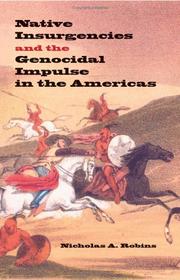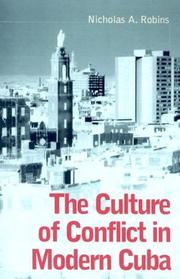| Listing 1 - 10 of 10 |
Sort by
|
Book
ISBN: 0253356512 9786613235916 0253005388 1283235919 9780253005380 9780253356512 9781283235914 6613235911 Year: 2011 Publisher: Bloomington, IN Indiana University Press
Abstract | Keywords | Export | Availability | Bookmark
 Loading...
Loading...Choose an application
- Reference Manager
- EndNote
- RefWorks (Direct export to RefWorks)
On the basis of an examination of the colonial mercury and silver production processes and related labor systems, Mercury, Mining, and Empire explores the effects of mercury pollution in colonial Huancavelica, Peru, and Potosí, in present-day Bolivia. The book presents a multifaceted and interwoven tale of what colonial exploitation of indigenous peoples and resources left in its wake. It is a socio-ecological history that explores the toxic interrelationships between mercury and silver production, urban environments, and the people who lived and worked in them. Nicholas A. Robins tells the
Environmental degradation --Bolivia --Potosi ́ (Dept.). --- Environmental degradation --Peru --Huancavelica. --- Indians, Treatment of --Bolivia --Potosi ́ (Dept.) --History. --- Indians, Treatment of --Peru --Huancavelica --History. --- Mercury mines and mining --Environmental aspects --Peru --Huancavelica. --- Mercury mines and mining --Health aspects --Peru --Huancavelica. --- Mercury mines and mining --Peru --Huancavelica --History. --- Silver mines and mining --Bolivia --Potosi ́ (Dept.) --History. --- Silver mines and mining --Environmental aspects --Bolivia --Potosi ́ (Dept.). --- Silver mines and mining --Health aspects --Bolivia --Potosi ́ (Dept.). --- Silver mines and mining --- Environmental degradation --- Mercury mines and mining --- Indians, Treatment of --- Metals, Heavy --- Environmental Pollution --- Transition Elements --- American Native Continental Ancestry Group --- Poisoning --- Extraction and Processing Industry --- History, Modern 1601 --- -Continental Population Groups --- Public Health --- Elements --- Metals --- Industry --- History --- Substance-Related Disorders --- Inorganic Chemicals --- Population Groups --- Diseases --- Environment and Public Health --- Technology, Industry, and Agriculture --- Humanities --- Chemicals and Drugs --- Persons --- Technology, Industry, Agriculture --- Health Care --- Named Groups --- Indians, South American --- Mining --- Silver --- Mercury --- History, 17th Century --- Mercury Poisoning --- Environmental Exposure --- Business & Economics --- Industries --- Health aspects --- Environmental aspects --- History. --- Degradation, Environmental --- Destruction, Environmental --- Deterioration, Environmental --- Environmental destruction --- Environmental deterioration --- Mercury industry and trade --- Mines and mineral resources --- Natural disasters --- Environmental quality --- Indians --- Government relations --- E-books
Book
ISBN: 0803284527 0803284500 9780803284524 9780803277199 0803277199 9780803284500 9780803284517 Year: 2015 Publisher: Lincoln
Abstract | Keywords | Export | Availability | Bookmark
 Loading...
Loading...Choose an application
- Reference Manager
- EndNote
- RefWorks (Direct export to RefWorks)
"An examination of the application of late-colonial Bourbon policies concerning marriage and intimacy, their effects on people's lives, and how they resisted them to create, and break, intimate bonds in colonial Charcas"-- "Policies concerning marriage, morality, and intimacy were central to the efforts of the Spanish monarchy to maintain social control in colonial Charcas. The Bourbon Crown depended on the patriarchal, caste-based social system on which its colonial enterprise was built to maintain control over a vast region that today encompasses Bolivia and parts of Peru, Chile, Paraguay, and Argentina. Intimacy became a fulcrum of social control contested by individuals, families, the state, and the Catholic Church, and deeply personal emotions and experiences were unwillingly transformed into social, political, and moral challenges. In Of Love and Loathing, Nicholas A. Robins examines the application of late-colonial Bourbon policies concerning marriage, morality, and intimacy. Drawing on archival sources, Robins examines how such policies and the means by which they were enforced highlight the moral, racial, and patriarchal ideals of the time, and, more important, the degree to which the policies were evaded. Not only did free unions, illegitimate children, and de facto divorces abound, but women also had significantly more agency regarding resources, relationships, and movement than has previously been recognized. A surprising image of society emerges from Robins's analysis, one with considerably more moral latitude than can be found from the perspectives of religious doctrine and regal edicts"--
HISTORY / Latin America / South America. --- Domestic relations --- Marriage --- Married life --- Matrimony --- Nuptiality --- Wedlock --- Love --- Sacraments --- Betrothal --- Courtship --- Families --- Home --- Honeymoons --- Family law --- Persons (Law) --- Sex and law --- History --- Law and legislation --- Spain --- Charcas (Audiencia) --- Charcas (Bolivia) --- La Plata (Bolivia) --- Chuquisaca (Bolivia) --- Sucre (Bolivia) --- Real Audiencia de Charcas --- Audiencia de Charcas --- Upper Peru (Audiencia) --- Chuquisaca (Audiencia) --- Audiencia de La Plata de Los Charcas --- La Plata de Los Charcas (Audiencia) --- La Plata (Audiencia) --- Espagne --- Espainiako Erresuma --- España --- Espanha --- Espanja --- Espanya --- Estado Español --- Hispania --- Hiszpania --- Isupania --- Kingdom of Spain --- Regne d'Espanya --- Reiaume d'Espanha --- Reino de España --- Reino d'Espanya --- Reinu d'España --- Sefarad --- Sepharad --- Shpanie --- Shpanye --- Spanien --- Spanish State --- Supein --- イスパニア --- スペイン --- Colonies --- Administration --- Politics and government --- Social life and customs

ISBN: 0253111676 9780253111678 9780253346162 0253346169 1282072668 9781282072664 9786612072666 Year: 2005 Publisher: Bloomington Indiana University Press
Abstract | Keywords | Export | Availability | Bookmark
 Loading...
Loading...Choose an application
- Reference Manager
- EndNote
- RefWorks (Direct export to RefWorks)
This book investigates three Indian revolts in the Americas: the 1680 uprising of the Pueblo Indians against the Spanish; the Great Rebellion in Bolivia, 1780--82; and the Caste War of Yucatan that began in 1849 and was not finally crushed until 1903. Nicholas A. Robins examines their causes, course, nature, leadership, and goals. He finds common features: they were revitalization movements that were both millenarian and exterminatory in their means and objectives; they sought to restore native rule an
Pueblo Revolt, 1680. --- Pueblo Rebellion, 1680 --- Pueblo Indians --- Wars --- Tupak Katari, --- Tupac-Amaru, Jose Gabriel, --- Katari, Tupak, --- Túpac Catari, --- Apaza Nina, Julián, --- Apaza, Julián, --- Nina, Julián Apaza, --- Tupac Katari, --- Amaru, José Gabriel Tupac-, --- Condorcanki Noguera, José Gabriel, --- Condorcanqui, José Gabriel, --- Condorcanqui y Noguera, José Gabriel, --- Quivicanqui, José Gabriel, --- Quibi Canqui, José Gabriel, --- Canqui, José Gabriel Quibi, --- Noguera, José Gabriel Condorcanqui y, --- Thupa Amaro, --- Túpac Amaru, --- Tupac-Amaru, José Gabriel, --- Tupaj Amaru --- Tupak Amaru, --- La Paz (Bolivia) --- Peru --- Yucatán (Mexico : State) --- Bolivia --- History --- Amaru, José Gabriel Túpac, --- Túpaj Amaru --- Túpak Amaru, --- Yucatan (Mexico : State)

ISBN: 0786414154 Year: 2003 Publisher: Jefferson,NC : McFarland & Company,
Abstract | Keywords | Export | Availability | Bookmark
 Loading...
Loading...Choose an application
- Reference Manager
- EndNote
- RefWorks (Direct export to RefWorks)
Elite (Social sciences) --- Culture conflict --- Cuba --- Politics and government --- History --- Politique et gouvernement --- Histoire
Book
ISBN: 9004343792 9004339787 Year: 2017 Publisher: Leiden, Netherlands ; Boston, [Massachusetts] : Brill,
Abstract | Keywords | Export | Availability | Bookmark
 Loading...
Loading...Choose an application
- Reference Manager
- EndNote
- RefWorks (Direct export to RefWorks)
In Santa Bárbara’s Legacy: An Environmental History of Huancavelica, Peru , Nicholas A. Robins presents the first comprehensive environmental history of a mercury producing region in Latin America. Tracing the origins, rise and decline of the regional population and economy from pre-history to the present, Robins explores how people’s multifaceted, intimate and often toxic relationship with their environment has resulted in Huancavelica being among the most mercury-contaminated urban areas on earth. The narrative highlights issues of environmental justice and the toxic burdens that contemporary residents confront, especially many of those who live in adobe homes and are exposed to mercury, as well as lead and arsenic, on a daily basis. The work incorporates archival and printed primary sources as well as scientific research led by the author.
Mercury mines and mining --- Indians, Treatment of --- Environmental aspects --- History. --- Health aspects --- Huancavelica (Peru) --- Environmental conditions.
Book
ISBN: 9789004688223 9789004691865 9004691863 Year: 2024 Publisher: Leiden, The Netherlands : Brill,
Abstract | Keywords | Export | Availability | Bookmark
 Loading...
Loading...Choose an application
- Reference Manager
- EndNote
- RefWorks (Direct export to RefWorks)
Taking a long view of history, this work explores the colonial roots, modern context, trajectory and complex legacy of the Shining Path insurgency in the region of Huancavelica, Peru.
Insurgency --- Political violence --- Postwar reconstruction --- Interviews --- Collective memory --- History. --- Social aspects --- Sendero Luminoso (Guerrilla group) --- Huancavelica (Peru : Region) --- Rural conditions.
Book
ISBN: 9004691863 9004688226 Year: 2024 Publisher: Boston : BRILL,
Abstract | Keywords | Export | Availability | Bookmark
 Loading...
Loading...Choose an application
- Reference Manager
- EndNote
- RefWorks (Direct export to RefWorks)
Taking a long view of history, this work explores the colonial roots, modern context, trajectory and complex legacy of the Shining Path insurgency in the region of Huancavelica, Peru.
Insurgency --- Political violence --- Postwar reconstruction --- Interviews --- Collective memory --- History. --- Social aspects --- Sendero Luminoso (Guerrilla group) --- Huancavelica (Peru : Department) --- Rural conditions. --- Huancavelica (Peru : Region)
Book
ISBN: 9789004343795 9789004339781 Year: 2017 Publisher: Leiden ;Boston Brill
Abstract | Keywords | Export | Availability | Bookmark
 Loading...
Loading...Choose an application
- Reference Manager
- EndNote
- RefWorks (Direct export to RefWorks)
Book
ISBN: 9786612238222 1282238221 0253002974 9780253002976 9781282238220 6612238224 9780253353092 0253353092 9780253220776 0253220777 Year: 2009 Publisher: Bloomington, IN Indiana University Press
Abstract | Keywords | Export | Availability | Bookmark
 Loading...
Loading...Choose an application
- Reference Manager
- EndNote
- RefWorks (Direct export to RefWorks)
In the last two decades, the field of comparative genocide studies has produced an increasingly rich literature on the targeting of various groups for extermination and other atrocities, throughout history and around the contemporary world. However, the phenomenon of "genocides by the oppressed," that is, retributive genocidal actions carried out by subaltern actors, has received almost no attention. The prominence in such genocides of non-state actors, combined with the perceived moral ambiguities of retributive genocide that arise in analyzing genocidal acts "from below," have so far eluded serious investigation. Genocides by the Oppressed addresses this oversight, opening the subject of subaltern genocide for exploration by scholars of genocide, ethnic conflict, and human rights. Focusing on case studies of such genocide, the contributors explore its sociological, anthropological, psychological, symbolic, and normative dimensions.
Ethnic conflict. --- Genocide. --- Conflict, Ethnic --- Ethnic violence --- Inter-ethnic conflict --- Interethnic conflict --- Ethnic relations --- Social conflict --- Cleansing, Ethnic --- Ethnic cleansing --- Ethnic purification --- Ethnocide --- Purification, Ethnic --- Crime --- Ethnic conflict --- Genocide --- #SBIB:327.5H20 --- #SBIB:39A11 --- Vredesonderzoek: algemeen --- Antropologie : socio-politieke structuren en relaties
Book
ISBN: 1496221397 1496221419 9781496221414 9781496221391 9781496221407 1496221400 9781496208026 1496208021 Year: 2020 Publisher: Lincoln
Abstract | Keywords | Export | Availability | Bookmark
 Loading...
Loading...Choose an application
- Reference Manager
- EndNote
- RefWorks (Direct export to RefWorks)
"Landscapes of Inequity examines a range of environmental justice issues in the Andes and western Amazon basin from the perspectives of indigenous peoples and economic development in a global economy"--
Economic development --- Ethnoecology --- Environmental justice --- Environmental aspects --- Amazon River Region --- Andes Region --- Environmental conditions
| Listing 1 - 10 of 10 |
Sort by
|

 Search
Search Feedback
Feedback About UniCat
About UniCat  Help
Help News
News